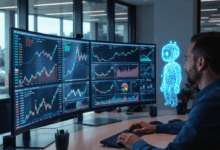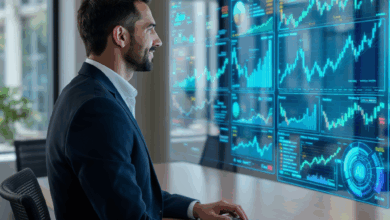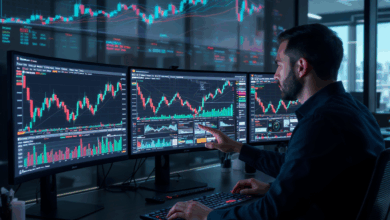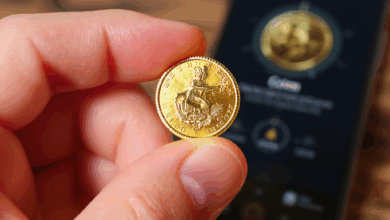Trading Platforms with Integrated AI Analysis Tools – An Honest Look After a Month of Use

Have you ever wondered whether AI-driven trading platforms truly live up to the hype? When I first heard about tools that promise to analyze markets, generate signals, and optimize portfolios using artificial intelligence, I felt both intrigued and skeptical. Could these platforms really replace some of the intuition and deep analysis that human traders rely on?
Diving in, I decided to test several prominent AI-integrated trading platforms over the past month, aiming to uncover not just their advertised strengths but also the everyday realities of using them. From Trade Ideas’ AI assistant “Holly” to TrendSpider’s automated technical analysis and Kavout’s predictive “K Score,” each brought something unique to the table. But the experience wasn’t without its surprises.
For example, Trade Ideas offers AI-generated stock signals that can feel like a helpful guide when markets are volatile, yet I found that relying solely on these signals sometimes led to missed contextual cues—those subtle factors that no algorithm can fully grasp. Similarly, TrendSpider’s multi-timeframe pattern recognition automated much of the tedious chart analysis, freeing up time but requiring a learning curve to interpret its outputs effectively.
On the flip side, platforms like TradingView impressed me with their blend of advanced charting and social trading communities, where human insight still plays a vital role alongside AI tools. Kavout’s “K Score” intrigued me as a quantitative indicator for stock performance, but I noticed that unexpected market events could quickly disrupt its predictions.
What struck me most was how these AI features could both empower and complicate decision-making. The automation and data crunching are powerful, yet they don’t eliminate the need for human judgment. I also discovered practical tips along the way—like backtesting strategies with TrendSpider before risking capital, or ensuring the platform seamlessly integrates with my brokerage account to avoid execution delays.
So, is jumping into AI-powered trading platforms a game changer? It certainly adds a compelling layer of analysis and efficiency. But it also raises questions about balancing trust in algorithms with personal insight. Wouldn’t it be fascinating to explore how these tools evolve and whether they can eventually adapt to the nuances of human market psychology?
If you’re curious like me, this exploration might help you decide whether these AI platforms can truly fit your trading style—or if they’re best approached as complementary aids rather than replacements. After all, trading is as much art as science, and perhaps AI’s role is to sharpen the brush, not paint the whole picture.
When AI Meets Trading More Than Just Algorithms
I still remember the moment I first stumbled upon Trade Ideas’ AI assistant, “Holly.” It was like meeting a new kind of trading partner—not a human, but something designed to mimic that intuitive spark we often rely on. Yet, as I spent more time with Holly and its counterparts across other platforms, I realized that AI in trading isn’t simply about replacing human intuition but augmenting it in ways we hadn’t fully appreciated.
Why Does This Matter Now?
The financial world is evolving rapidly. Just recently, Anthropic’s launch of “Claude for Financial Services” caught my attention. Tailored specifically for the financial sector, it aims to streamline complex research and compliance tasks. At the same time, Robinhood’s acquisition of Pluto Capital signals a clear industry trend: AI is becoming integral to trading strategies, data analysis, and personalized investment advice. These developments aren’t isolated; they reflect how AI tools are reshaping the landscape, making it essential for traders like us to understand and adapt.
Diving Deeper What These Platforms Really Offer
Each AI-powered platform brings unique features to the table. Take TrendSpider, for example. Its automated technical analysis and multi-timeframe pattern recognition can save hours that traders traditionally spend poring over charts. Yet, mastering the interpretation of these outputs requires patience and practice. It’s not a magic wand but a sophisticated assistant.
Similarly, Tickeron’s AI trend predictions and virtual accounts introduce automated money management that feels like having a co-pilot during turbulent market flights. But as any seasoned trader knows, unexpected market shocks can sidestep even the most advanced algorithms.
Then there’s Kavout with its intriguing “K Score.” This proprietary rating predicts stock performance for the near term, offering a quantitative edge. However, I noticed that sudden news events or shifts in market sentiment often challenge these predictions, reminding me that no AI is infallible.
The Balancing Act Trusting AI Without Losing Yourself
One recurring theme I encountered is this delicate balance between leveraging AI’s strengths and maintaining personal judgment. AI-generated signals from platforms like Trade Ideas can highlight opportunities during volatile periods, but sometimes they miss the subtle, contextual hints a human eye might catch. This made me wonder—how much should we lean on AI before it starts to dull our own trading instincts?
Backtesting features, available on TrendSpider and Tickeron, emerged as invaluable tools in this regard. They let us experiment with strategies against historical data, providing a safer space to learn and adapt before committing real capital.
What Should You Keep in Mind?
-
Compatibility is Key: Ensure the platform integrates smoothly with your brokerage and supports your preferred assets. Nothing hampers trading faster than execution delays or mismatched interfaces.
-
Know Your AI: Different platforms emphasize different AI capabilities—whether it’s predictive analytics, pattern recognition, or portfolio optimization. Understanding these nuances helps in selecting the right tool for your style.
-
Stay Updated: AI technology evolves quickly. Keeping an eye on platform updates and emerging features can give you a competitive edge.
So, Is AI the Future of Trading or Just Another Tool?
From my journey, it’s clear that AI-powered trading platforms add a fascinating layer of analysis and efficiency. But they don’t eliminate the human element—they complement it. The art of trading still thrives on experience, intuition, and adaptability.
What intrigues me now is how these AI systems might evolve to better grasp the nuances of human market psychology. Could future iterations learn to sense market sentiment as deeply as a seasoned trader? Or will there always be an unbridgeable gap?
Perhaps the better question is: How can we, as traders, cultivate a partnership with AI—one that sharpens our tools without dulling our instincts? I’d love to hear your thoughts as we navigate this unfolding frontier together.
Experience this evolving landscape yourself. Explore these AI-driven trading platforms, test their features, and see how they resonate with your trading approach. The conversation between human insight and artificial intelligence is just beginning—how will you join it?

Looking back on this exploration of AI-powered trading platforms, what stands out is not just their technological prowess but the nuanced dance they invite between human intuition and machine analysis. These tools—from Trade Ideas’ Holly to Kavout’s K Score—bring remarkable capabilities that can streamline and enrich our trading decisions. Yet, as I noticed firsthand, they are far from flawless or all-encompassing. The subtle market signals, unexpected events, and emotional undercurrents that shape trading often escape even the most sophisticated algorithms. This ultimately means that while AI can significantly sharpen our analytical edge, it remains an accompaniment rather than a replacement for our judgment.
By engaging with these platforms, we’ve glimpsed how AI is reshaping the trading landscape—making it faster, data-driven, and in some ways more accessible. The real value, I believe, lies in understanding how to harness these tools thoughtfully: integrating their insights with our experience, rigorously backtesting strategies, and carefully choosing platforms compatible with our needs. This balance is perhaps the key to navigating tomorrow’s markets where human and artificial intelligence coexist.
So, what can you do now? If you’re intrigued, don’t just take my word for it—dive in and test these AI features yourself. Experiment with backtesting, observe how AI signals align or diverge from your instincts, and reflect on what feels empowering versus overwhelming. Keep abreast of emerging developments too, as this space evolves rapidly and surprises await.
Looking ahead, I wonder how these intelligent systems might grow—not only in predictive power but in sensitivity to the human elements of trading psychology. Could future AI learn to sense moods or market sentiment with the same subtlety as seasoned traders? Or will there always be a uniquely human spark that machines cannot replicate? Perhaps the most exciting journey is discovering how we, as traders, foster a genuine partnership with AI—one that enhances without eclipsing our insight.
What do you think? How might you shape this evolving relationship between your intuition and artificial intelligence? If this reflection has sparked your curiosity, I encourage you to explore these platforms firsthand and find your own rhythm in this unfolding dialogue. After all, the art and science of trading continue—now with a new, intriguing partner at our side.





